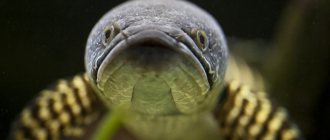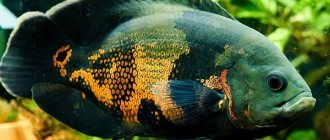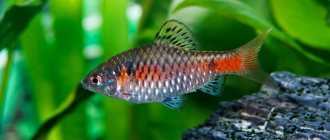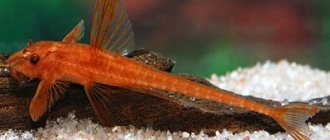Habitat in nature
Under natural conditions, these creatures live in the warm waters of shallow rivers, whose bottom is covered with fallen leaves. Tetras' home waters are located in tropical forests, their beds hidden by dense vegetation. The fish try to stay near snags attached to the bottom and live in schools.
Area
This breed of sea creatures inhabits the forests of South America. Various species of this group live in separate places in the Amazon basin. The fish came to Europe in the second half of the 20th century.
Variety of species
As for the diversity of tetra fish, there are a lot of species. They are divided more by appearance than by behavior and temperament. Next are the most popular types with photos.
African
Scientifically, Arnoldichthys spilopterus lives in the Congo. This is an unusual, rainbow fish, shimmering in many bright shades - from purple to yellow. They have an elongated body and large scales.
White
Gymnocorymbus ternetzi, artificially bred from the Black Tetra. High body, large, veil fins, transparent color. Undemanding, perfect for a beginning breeder.
Diamond
Moenkhausia pittieri, found in Venezuela. It has an oval, slightly elongated body, yellowish-gray color. A distinctive feature of the breed is its scales, which can reflect and break light into rainbow reflections, like a diamond.
Blue
Alestopetersius smykalai, native to Nigeria. Almost disappeared in nature, its export is prohibited. Color - silver with a blue tint. The body is long, slightly compressed at the sides.
Green stripe
Iguanodectes spilurus, or Tetra Iguana. Found throughout the Amazon. It is large in size - up to 10 cm. A distinctive feature is a green stripe along the body.
Golden
Hemigrammus rodwayi, live in the Amazon, at the crossroads of salt and fresh waters. Famous for their characteristic golden color. At the same time, individuals raised in captivity lose this shade, becoming silver.
Exquisite
Scientific name: Hyphessobrycon bentosi, found in slow-flowing tributaries. Pink body, black markings on fins with white tips.
Colombian
Hyphessobrycon columbianus, lives in the Acandi River on the border between Panama and Colombia. The color is double - blue on the back turns into silver towards the belly.
Royal
Nematobrycon palmeri, native to northwestern Colombia. The coloring of the royal tetra is unusual - its transparent, purple-tinged back is intersected by a black stripe, turning into a dark-colored abdomen. The most popular of the entire group of tetras.
Red
Hyphessobrycon flammeus, found in eastern Brazil. Notable for the bright fiery tint of its scales. If the fish is stressed, the color may fade.
Lemon
Hyphessobrycon pulchripinnis, native to the Peruvian Amazon. It is distinguished by its lemon color, which is also an indicator of the condition of the individual. If the scales turn pale, the fish is unhealthy.
Blue
Mimagoniates microlepis, lives in southeastern waters of Brazil. They have pale blue scales. During the mating season they are capable of emitting sound signals with their swim bladder.
Tetra
It is also called Ordinary. Scientific name: Prionobrama filigera. It has a diamond-shaped body and an adipose fin behind the dorsal. Lives up to 6 years, lives in schools. Characterized by a calm and peaceful disposition.
Ulreya
Hemigrammus ulreyi, lives in Paraguay. Gray scales, longitudinal stripe of black and yellow color throughout the body.
Schultz
Name - Hyphessobrycon haraldschultzi, family Сharacins, habitat - Araguaia River. It is distinguished by its red hue and dwarf size.
Black (Veil)
Gymnocorymbus ternetzi, derived from the Black Tetra. Its peculiarity is its long, voluminous fins, the size of the fish itself. The color of the body and tail is silver, and the dorsal and anal fins are inky black.
Sex differences
Males of this breed are larger than females and are much brighter in color. Males have a black stripe running along the side of the ventral and anal fins. The female's tail is pink.
Reviews from tetra owners
Ruslan, review of the rainbow tetra, Royal Congo
Active. Pleasant bluish-neon color despite the fact that the size of the fish is quite large (neons are also beautiful colors, but small ones are not so impressive). Beautiful veil fins of males. School behavior is quite pronounced, occupying almost exactly the average water level. They eat very well both frozen bloodworms and dry food. Contained at pH=8.0 - 8.5, t=26.
I bought 10 pieces about 6-7 cm in size, they are kept in a common aquarium with gouramis (young ones of the same size), Sumatran barbs (young 4-5 cm in size), mollies (young ones 6-7 cm in size) and catfish (2 tiny ancitrus) and 4 speckled corydoras catfish. Only on the first day I watched how the largest of the gourami tried to chase one fish from the school and then another, now everyone has settled down.
Nikolay, review of Rhodostomus (red-mouthed tetra)
I’ve had it for about 10 years now. It’s really very unpretentious. They withstood the hot summer of 2010 very well, when the water temperature remained around 37-38 degrees for a week. C. (Ancistrus died). “Live” they look much more impressive than in photographs: a more saturated crimson head color and a bright striped tail. The larger the flock, the better the look and the more interesting the behavior, the more clearly the flock behavior is expressed. I think that 10 pieces is the minimum group. They get along well with all peaceful fish. But they are especially impressive in a monospecies aquarium with a large group (50 - 100 individuals): the school moves as one organism - all the fish simultaneously instantly change the direction of movement. Looks amazing.
In more than ten years of experience in maintaining it, I have not noticed any obvious shortcomings. It is possible to lose several especially weak individuals from a newly acquired flock, but this, alas, is an inevitable cost of amateur aquarium keeping. They live well on dry, live and frozen food.
Elena, review of the copper tetra (hasemania)
A very active fish, not whimsical, easy to keep. Not hooligans. Sometimes they bite each other, but no harm, even the scales are still there. The fish is very interesting and active. They love to chase each other in thickets of grass. Males, when they sort things out among themselves, become a very rich copper color and circle, finely trembling their fins. It is better to keep a flock of 6-7 pieces; smaller numbers get lost in the general background and do not keep a flock.
Character and behavior
Tetra is a calm and peaceful pet. They do not spoil the landscape and algae. This breed lives in flocks, so it is advisable to place at least 7 individuals in the aquarium at once. Lonely individuals become aggressive.
Compatibility with other types
Tetras coexist well with species of similar sizes and the same calm temperament:
- guppy;
- neon;
- catfish;
- discus;
- mollies.
You should not place these species in the same aquarium with them:
- gold fish;
- cichlid;
- barb;
- astronotus.
Larger and more temperamental fish will annoy timid characionids and take away food.
Sex differences
The distinctive features of the tetra are not obvious. Male individuals are often distinguished by more pronounced colors (although in unfavorable environments their colors become paler) and larger sizes. There are exceptions. For example, the male mirror tetra is smaller than the female, although it differs in the color of the anal fin (the male has a silver-white edge, while the female has white only at the tip). During spawning, the female can still be distinguished by her larger abdomen.
In the tetra minor, the male is also slimmer than the female, has a white stripe on the anal fin (while the female has only a small dot), and is more brightly colored.
Conditions of detention
Caring for characins is not so difficult if you know a few simple rules and take into account important points.
Choosing an aquarium
When purchasing, you should pay attention to the following points:
- volume - average, from 60 to 100 liters;
- the shape is preferably rectangular;
- soil - dark gravel or sand, with the addition of dry leaves;
- There should be a lot of vegetation: moss, duckweed, fern, elodea.
Characins prefer dim lighting; their color fades from direct rays. The glass tetra requires particularly thick shade to show off its uniqueness.
Water parameters
Now a few words about water:
- characins need clean, settled water without chlorine;
- temperature - about 22-26°C;
- acidity - not higher than 7;
- hardness - no higher than 15;
- The water is changed once a week in a volume of 1/6.
It will be useful to saturate your pets' habitat with tannins.
Necessary equipment
To create suitable conditions you will need special equipment.
These devices are worth purchasing:
- thermostat and thermometer - to prevent temperature changes;
- water filter, preferably peat;
- an aerator that saturates the water with oxygen.
It’s a good idea to set up a small darkened corner for the fish. The entire characidae family tends to hide in its natural habitat.
Scenery
Tetras are undemanding when it comes to decoration. The best design for an aquarium will be floating plants. At the same time, you should not place shells and stones in the aquarium - they can change the balance of minerals, which will lead to stress in its inhabitants. The tank should be installed in a quiet corner, since characins do not tolerate noise or excessive activity around them.
Feeding and diet
Tetras are not too demanding when it comes to nutrition. They readily eat live food - cyclops, bloodworms, daphnia, brine shrimp, tubifex, and do not refuse dry granulated food. The fish's diet should be varied, rich in additives - vegetable, egg yolks, as well as finely crushed oatmeal. Feeding occurs twice a day - morning and evening.
Feeding the fry
In the first days of feeding, the fry are given a slipper ciliate and hard-boiled egg yolk. Two-week-old young animals are transferred to live food - cyclops, rotifers, echintraeus, artemia nauplii, while continuing to produce yolk. At first, feeding is done every 3-4 hours, then the interval is increased to 6-7 times a day.
Description
Tetras belong to the Characin family. These are predators, their natural food is small crustaceans, insects and invertebrates .
Despite the species diversity, the main characteristics of the fish are similar: they have a flexible, elongated body, shaped like a diamond.
A distinctive feature of these fish is their bright scales, which, depending on the species characteristics, can have the most incredible colors.
The fins are not too large. Many representatives have a wen behind the dorsal fin without bone spines.
Size
Tetras are medium-sized fish, often their body does not exceed 5 cm in length , but there are several large representatives whose length can even reach 20 cm. Males are usually slightly larger than females, and their coloring is brighter.
Major diseases
Under favorable conditions, tetras rarely get sick. They are mainly susceptible to typical diseases of tropical breeds.
Diseases associated with unfavorable environment:
- alkalosis and acidosis, pH shock - occur due to inappropriate pH values;
- osmotic stress and shock - from changes in the mineral composition of water;
- poisoning - may occur due to harmful substances entering the tank;
- new aquarium syndrome - if the balance of minerals in the aquarium is not stable.
All these diseases have similar symptoms - anxiety, changes in color and behavior, difficulty breathing, loss of appetite. There is only one treatment - to normalize the balance of minerals in the aquarium as quickly as possible.
Characins are also susceptible to infectious diseases:
- dropsy;
- bulging eyes;
- fin rot - treated with medicine based on phenoxyethanol;
- mouth rot (fungus) - treatment is the same;
- tuberculosis;
- ulcers - they are treated with the same phenoxyethanol.
If symptoms of the disease appear - loss of appetite, strange behavior, marks and formations on the body - you should immediately isolate the sick individual and consult a specialist.
Reproduction
Characins reach sexual maturity at the age of 6 months. In aquarium conditions, young animals can appear in large schools every month. This breed has high fertility, but cannot boast of a developed parental instinct.
Creating suitable conditions
Strong and healthy individuals selected for spawning are placed in a special tank, while males and females are separated. The fish are fed live food for about 10 days.
The parameters of the spawning aquarium are observed as follows: temperature 26-27 ° C, hardness not higher than 4, acidity - 6.7. The bottom is covered with a nylon mesh (permeable to eggs), or Java moss, and a washcloth and plants with small leaves are placed there.
Spawning and raising fry
The signal for the start of spawning is a decrease in acidity and an increase in temperature and pressure in the tank. To do this, water is mixed with distilled water and enriched with peat extract. Females and males are released, and, after a couple of days, mating games begin. A female tetra lays up to 300 eggs during one spawning. After the spawning is over, the fish are removed from the tank, as they may eat their own eggs. The water in the spawning tank is changed almost completely. After a few hours, unfertilized eggs acquire a whitish-cloudy hue and should be removed immediately.
The young hatch on average after five days. The fry do not tolerate bright light, so the walls of the tank should be darkened. The temperature is maintained at 24-26 degrees. Aeration is not recommended. The juveniles are fed live dust and plankton. The spawning tank should be kept perfectly clean to prevent rot and infection.
How to increase the survival rate of fry
The fry are quite independent, but they need good conditions. It is useful to add trypaflavin to water. High-quality, rapid growth and survival are facilitated by dim, diffused lighting directed from above. Do not forget about oxygenation and frequent filtration, removing uneaten food and dead larvae. Over the course of two weeks, the fry gradually become accustomed to the parameters of the environment that are comfortable for adults.
Breeding
Despite all its unpretentiousness, the tetra fish is difficult to reproduce. The reasons are infertility of females who manage to become obese.
To achieve offspring, fish must be placed in a spawning tank in groups with a predominance of males. You will have to try, as it will require “dancing with a tambourine.”
“Guys” and “ladies” need to be seated and simulate rain using regular and abundant water changes. Pets must be fed “for slaughter” during this period. After spawning, during which one female can bring up to 300 eggs, the parents are removed. The fry will develop completely independently.
Results
Thus, final conclusions can be drawn about this breed of the characin family. The tetra is a small, brightly colored fish that comes in many unique varieties. She has a peaceful character, lives in flocks, is unpretentious in maintenance and is quite easy to breed. The tetra will make a wonderful pet and will give its owner many pleasant moments of contemplation, filled with peace and tranquility.











